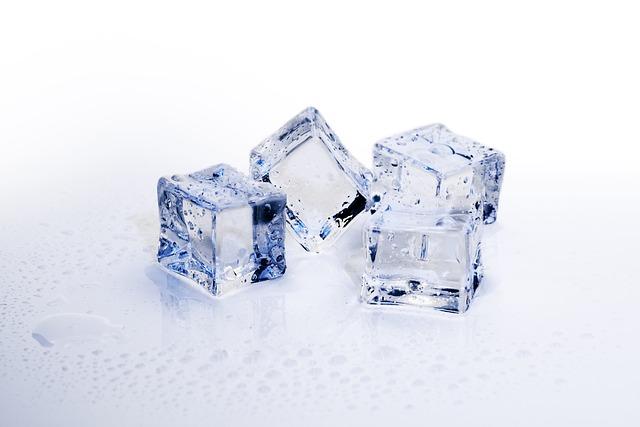How Much Ice Do I Need for an Ice Bath? Cold Therapy Essentials

Are you curious about the optimal amount of ice needed to achieve the most effective ice bath? Look no further, as we unveil the essential details of cold therapy in our article titled "How Much Ice Do I Need for an Ice Bath? Cold Therapy Essentials." Whether you’re an athlete looking to recover faster or an individual seeking the numerous health benefits of cold therapy, we’ve got you covered. Get ready to delve into the chilly world of ice baths and discover the precise measurements that will maximize your cold therapy experience. So, sit back, relax, and prepare to immerse yourself in our informative guide that will leave you feeling confident, knowledgeable, and ready to embrace the invigorating power of an ice bath.
Contents
- 1. Understanding the Science Behind Ice Baths: Optimal Temperature and Duration
- 2. Selecting the Right Amount of Ice for Effective Cold Therapy
- 3. Calculating the Ideal Ice-to-Water Ratio for Maximum Cooling Benefits
- 4. Enhancing Your Ice Bath Experience with Additional Cold Therapy Accessories
- 5. Exploring Alternative Options for Cold Therapy: Ice Packs vs. Ice Baths
- 6. Tailoring the Ice Bath Intensity to Your Personal Fitness Goals and Recovery Needs
- 7. Best Practices for Preparing and Maintaining an Ice Bath at Home
- 8. Unveiling the Potential Health Benefits of Regular Ice Baths and Cold Therapy
- 9. Combining Cold Therapy with Heat Therapy: An Effective Recovery Approach
- 10. Expert Tips and Tricks for Optimizing Your Ice Bath Experience
1. Understanding the Science Behind Ice Baths: Optimal Temperature and Duration
Ice baths are a popular form of cold therapy that can provide numerous benefits for athletes and individuals looking to enhance their recovery. Understanding the science behind ice baths is crucial to ensure you maximize their effectiveness. One important factor to consider is the optimal temperature for an ice bath.
Experts recommend keeping the temperature between 50 and 59 degrees Fahrenheit (10-15 degrees Celsius). This temperature range is cold enough to initiate the body’s physiological response to cold exposure, triggering vasoconstriction, reducing inflammation, and aiding in muscle recovery. It is important to note that extremely cold temperatures can be detrimental and may decrease the therapeutic benefits of the ice bath.
In terms of duration, the general consensus among experts is to aim for 10 to 15 minutes. This timeframe allows the body to experience the desired physiological effects without causing any potential harm. However, it is crucial to listen to your body and adjust the duration according to your comfort level. Some individuals may find that they can tolerate longer or shorter durations, and that’s perfectly normal.
To optimize your ice bath experience, consider adding ice cubes or ice packs to maintain a steady and cool temperature throughout the session. Additionally, having a thermometer in the water can help ensure that the desired temperature range is maintained. Remember to always consult with a healthcare professional or a qualified trainer before incorporating ice baths into your routine, particularly if you have any underlying health conditions.
2. Selecting the Right Amount of Ice for Effective Cold Therapy
When it comes to cold therapy, selecting the right amount of ice is crucial for achieving maximum effectiveness. Whether you’re using an ice bath or applying ice packs to specific areas, having the correct ice-to-water ratio can make all the difference in your recovery process. Here are some essential tips to help you determine how much ice you need:
- Consider the size of your container: The amount of ice you’ll need depends on the size of the container you’re using. For an ice bath, choose a container that can comfortably accommodate your body while still leaving enough space to add the ice.
- Leave room for water displacement: Remember that when you step into the ice bath, the water level will rise due to your body’s displacement. Leave enough room so that the water doesn’t overflow once the ice is added.
- Aim for a 50/50 ratio: A generally recommended ice-to-water ratio for an ice bath is 50% ice and 50% water. This provides the ideal balance of cold temperature and therapeutic benefits.
In addition to these guidelines, it’s important to listen to your body and adjust the ice amount based on your personal comfort level. Experiment with different ratios to find what works best for you. Remember, the goal is to achieve cold therapy that feels invigorating and helps promote recovery.
3. Calculating the Ideal Ice-to-Water Ratio for Maximum Cooling Benefits
When it comes to taking an ice bath for cold therapy, getting the right ice-to-water ratio is crucial for maximizing the cooling benefits. This ratio determines how cold the water will be and how long you can comfortably stay in the bath.
To calculate the ideal ice-to-water ratio, you need to consider a few factors:
- The temperature you want the water to be: The colder the water, the more ice you will need. A typical ice bath temperature ranges from 50-59°F (10-15°C).
- The size of your ice bath tub or container: The larger the container, the more ice you will need to adequately cool the water.
- The duration of your ice bath: If you’re planning on staying in the bath for an extended period, you might need more ice to maintain the desired temperature.
As a general guideline, you can start with a 1:1 ratio of ice to water. For example, if you have a 5-gallon (approx. 19-liter) tub, you would add 5 gallons of ice to 5 gallons of water. If you prefer a colder bath, you can increase the ice volume to achieve a 2:1 or 3:1 ratio.
Remember, personal preference plays a role, so feel free to experiment and adjust the ice-to-water ratio according to your comfort level. Keep in mind that it’s always better to start with less ice and gradually add more if needed.
4. Enhancing Your Ice Bath Experience with Additional Cold Therapy Accessories
Ice baths can be an effective way to alleviate muscle soreness, reduce inflammation, and enhance recovery. While taking an ice bath is already a chilly experience, you can enhance it even further with additional cold therapy accessories. These accessories can help maximize the benefits of your ice bath and make the experience more enjoyable.
One essential accessory to consider is a cold therapy compression wrap. These wraps provide targeted cold therapy to specific areas of the body, such as the knees, ankles, or shoulders. They can help reduce swelling and discomfort in these areas, providing extra relief during your ice bath.
Another accessory you may want to add to your ice bath routine is an ice therapy ball. These balls are designed to be submerged in the ice water and then rolled over sore muscles for a deep tissue massage. The cold temperature of the ball helps to numb the area while the pressure helps to release tension and knots in the muscles.
Additionally, using a waterproof timer can be beneficial, especially if you’re new to ice baths. Setting a timer for your desired duration will help ensure you stay in the ice bath for the recommended time without the need to constantly keep track. This way, you can fully focus on the experience and let the cold therapy work its magic.
By incorporating these additional cold therapy accessories into your ice bath routine, you can enhance your overall experience and optimize the benefits of this effective recovery method. So don’t be afraid to get creative and experiment with different accessories to find the combination that works best for you. Your muscles will thank you!
5. Exploring Alternative Options for Cold Therapy: Ice Packs vs. Ice Baths
Ice baths and ice packs are both popular forms of cold therapy that can be used to reduce inflammation, alleviate pain, and promote recovery after intense physical activity. While both options have their merits, it’s important to understand the differences between them in order to choose the one that best suits your needs.
Ice packs are a convenient and portable option for targeted cold therapy. They can be easily applied to specific areas of the body that are experiencing pain or swelling. Ice packs are typically made of gel-like substances that become cold when frozen, providing a localized and controlled cooling effect. They are versatile and can be used on various body parts, such as the knees, ankles, or shoulders. However, it’s important to remember to wrap the ice pack in a cloth or towel to prevent direct contact with the skin, which can cause frostbite.
On the other hand, ice baths offer a more immersive and overall cooling experience. By submerging your body in cold water, usually between 10-15°C (50-59°F), the cold temperature affects multiple areas simultaneously. This can be particularly beneficial for athletes or those recovering from intense workouts, as it helps reduce muscle soreness and speeds up the recovery process. Ice baths are also known to improve circulation and boost the immune system. It’s important to note that ice baths should be done under supervision and should not exceed 15 minutes, as extended exposure to cold water can have adverse effects on the body.
In summary, ice packs are great for targeted cold therapy, while ice baths provide a more holistic cooling experience. Choosing between the two depends on the specific needs and preferences of the individual. It’s always a good idea to consult with a healthcare professional or a sports therapist to determine the best approach for you.
6. Tailoring the Ice Bath Intensity to Your Personal Fitness Goals and Recovery Needs
One of the key aspects of an ice bath is tailoring the intensity to your personal fitness goals and recovery needs. Whether you’re an athlete looking to speed up recovery after a tough workout or someone in need of general muscle relaxation, adjusting the ice bath intensity can make a significant difference. Here are some considerations to keep in mind when determining the right level of cold therapy for you:
1. Duration: The length of time spent in an ice bath can vary based on individual preferences and needs. Shorter durations, like 5-10 minutes, are often recommended for general muscle relaxation, while longer durations, such as 15-20 minutes, may be beneficial for more intense recovery or to target specific muscle groups.
2. Temperature: The temperature of the ice bath water is another important factor. It’s generally recommended to aim for a temperature between 50-59°F (10-15°C). However, for individuals who are new to cold therapy or have certain medical conditions, starting with warmer temperatures around 68-77°F (20-25°C) and gradually lowering it over time can be more suitable.
3. Gradual Progression: Just like any other form of exercise, it’s important to gradually increase the intensity of your ice baths over time. Start with shorter durations and warmer temperatures, then gradually decrease both as your body adapts. This approach helps to minimize the risk of shock to the system and allows for a more comfortable and effective experience.
Remember, is crucial in maximizing the benefits of cold therapy. Experiment with different durations and temperatures to find what works best for you. Always listen to your body and consult with a healthcare professional if you have any concerns or pre-existing conditions.
7. Best Practices for Preparing and Maintaining an Ice Bath at Home
Ice baths, also known as cold therapy, have gained popularity in recent years due to their numerous health benefits. From reducing inflammation to improving muscle recovery, ice baths are a great tool for athletes and fitness enthusiasts. However, preparing and maintaining an ice bath at home requires careful consideration to ensure a safe and effective experience. Here are some best practices to follow:
- Choose the right container: When selecting a container for your ice bath, consider its size and insulation capability. A deep and wide container is ideal to fully submerge your body, while a well-insulated one helps to maintain the desired temperature for a longer period. A bathtub or a large cooler can work well.
- Add enough ice: The amount of ice you need will depend on the size of your container and your personal preference. As a general rule of thumb, aim for a 50-50 ratio of ice to water. This ensures a temperature around 10-15 degrees Celsius (50-59 degrees Fahrenheit), which is ideal for cold therapy.
- Use a thermometer: To accurately monitor the temperature of your ice bath, invest in a reliable thermometer. Keeping the water within the recommended temperature range is crucial for maximizing the benefits and minimizing the risk of hypothermia or frostbite. Place the thermometer in the water before you get in.
- Take safety precautions: Always prioritize your safety when using an ice bath. Limit your sessions to 10-15 minutes and never stay in longer than necessary. If you start to shiver uncontrollably or feel numbness in your extremities, it’s time to end the session. Additionally, avoid using ice baths if you have any medical conditions that may be adversely affected by the extreme cold.
By following these best practices, you can enjoy the benefits of an ice bath in the comfort of your own home. Remember to listen to your body and adjust the temperature or duration as needed. Stay consistent with your cold therapy routine and you’ll reap the rewards of improved recovery and performance.
8. Unveiling the Potential Health Benefits of Regular Ice Baths and Cold Therapy
Regular ice baths and cold therapy have gained significant attention in recent years for their potential health benefits. From reducing inflammation to boosting athletic performance, these practices are believed to offer a range of advantages for both physical and mental well-being. But how much ice do you actually need for an ice bath? And what are the essential items you should have for effective cold therapy? Let’s dive in and explore these questions.
When it comes to ice baths, the amount of ice you need depends on your personal preference and tolerance for cold. While some individuals may prefer a brisk and icy plunge, others may find that a milder temperature and less ice are more suitable. It’s important to note that the objective of an ice bath is to cool the body, not freeze it. Gradually adding ice to a tub or container filled with cold water allows for a balance between therapeutic benefits and comfort.
To ensure a successful and comfortable ice bath experience, it’s important to have a few essentials on hand. Consider these items when preparing for your cold therapy session:
1. Ice packs or ice bags: These can be used to accelerate the cooling process or to target specific areas of the body that may be experiencing inflammation or soreness.
2. Thermometer: Having a thermometer at hand allows you to accurately measure the water temperature to ensure it’s within your desired range. Aim for a temperature between 50°F to 59°F (10°C to 15°C) for most therapeutic benefits.
3. Timer: Cold therapy sessions typically last between 10 to 20 minutes. Having a timer can help you track the duration and ensure you stay within the recommended time frame.
4. Towels and blankets: Once your ice bath is complete, you’ll want to have towels and blankets ready to quickly dry off and warm up your body. Wrapping yourself in a cozy blanket can help prevent any post-cold exposure shivers.
Remember, cold therapy should always be approached with caution and moderation. It’s important to listen to your body and consult with a healthcare professional before incorporating these practices into your routine. Stay cool, steady, and enjoy the potential health benefits of regular ice baths and cold therapy.
9. Combining Cold Therapy with Heat Therapy: An Effective Recovery Approach
Combining cold therapy with heat therapy can be an effective approach for enhancing recovery and relieving muscle soreness. Cold therapy, also known as cryotherapy, involves the use of ice or cold packs to promote vasoconstriction and reduce inflammation. Heat therapy, on the other hand, entails the application of heat to increase blood flow and relax muscles.
When it comes to ice baths, one common question is how much ice is needed to reap the benefits. The amount of ice required for an ice bath depends on various factors, including the size of the tub, water temperature, and individual preference. As a general guideline, aiming for a water temperature of around 50-60 degrees Fahrenheit (10-15 degrees Celsius) is recommended. To achieve this, you can start with around 10-15 pounds of ice for a standard-sized bathtub and adjust accordingly.
It’s essential to remember that the goal of an ice bath is not to create an extremely cold environment but rather to cool the body gradually. Additionally, it’s important to monitor your body’s response and always listen to your body. If you experience any discomfort or adverse effects, it’s best to consult with a healthcare professional before continuing with cold therapy. Incorporating heat therapy, such as a warm shower or heating pad, after the ice bath can further enhance the recovery process by increasing blood flow and relaxing muscles. Remember, finding the right balance between cold and heat therapy is key to maximizing their benefits and aiding in your overall recovery journey.
10. Expert Tips and Tricks for Optimizing Your Ice Bath Experience
Ice baths are a popular form of cold therapy that can provide numerous health benefits. But if you’re new to the world of ice baths, you might be wondering how much ice you actually need to make the experience effective. Well, fear not! We’ve got some expert tips and tricks to help you optimize your ice bath experience.
1. Fill your bathtub with cold water: Before adding the ice, make sure to fill your bathtub with cold water. The water should be deep enough to submerge your body up to your neck comfortably.
2. Use the right amount of ice: The amount of ice you use for your ice bath will depend on personal preference and tolerance to cold. As a general rule of thumb, start with a couple of bags of ice (around 10-15 pounds) and adjust as needed. You can always add more ice if you want a colder experience or reduce the amount if you find it too intense.
3. Consider adding Epsom salt: While not essential, adding Epsom salt to your ice bath can enhance the benefits. Epsom salt contains magnesium sulfate, which has been shown to help reduce inflammation and promote muscle recovery. Aim for about 1-2 cups of Epsom salt per bath, but feel free to adjust according to your preference.
4. Stay in for the right amount of time: It’s essential to gradually build up your tolerance to the cold. Start with shorter durations, around 5-10 minutes, and gradually increase the time as your body adjusts. Avoid staying in for too long, as prolonged exposure to cold can lead to discomfort and potential risks.
Remember, the key to optimizing your ice bath experience is to listen to your body. If at any point you feel uncomfortable or experience any adverse effects, it’s best to exit the ice bath immediately. Enjoy the cold therapy and reap the benefits of this invigorating and rejuvenating practice. In conclusion, understanding the amount of ice needed for an ice bath is crucial for maximizing the benefits of cold therapy. By following a few simple guidelines and taking into consideration factors like body size and water temperature, you can create the ideal ice bath experience. Remember, maintaining a confident and knowledgeable approach is key, so don’t be afraid to experiment and find what works best for you. Whether you’re an athlete recovering from a rigorous workout or simply seeking relief from everyday aches and pains, incorporating ice baths into your routine can be a game-changer. So go ahead, take the plunge and embrace the power of cold therapy. Your body will thank you.















